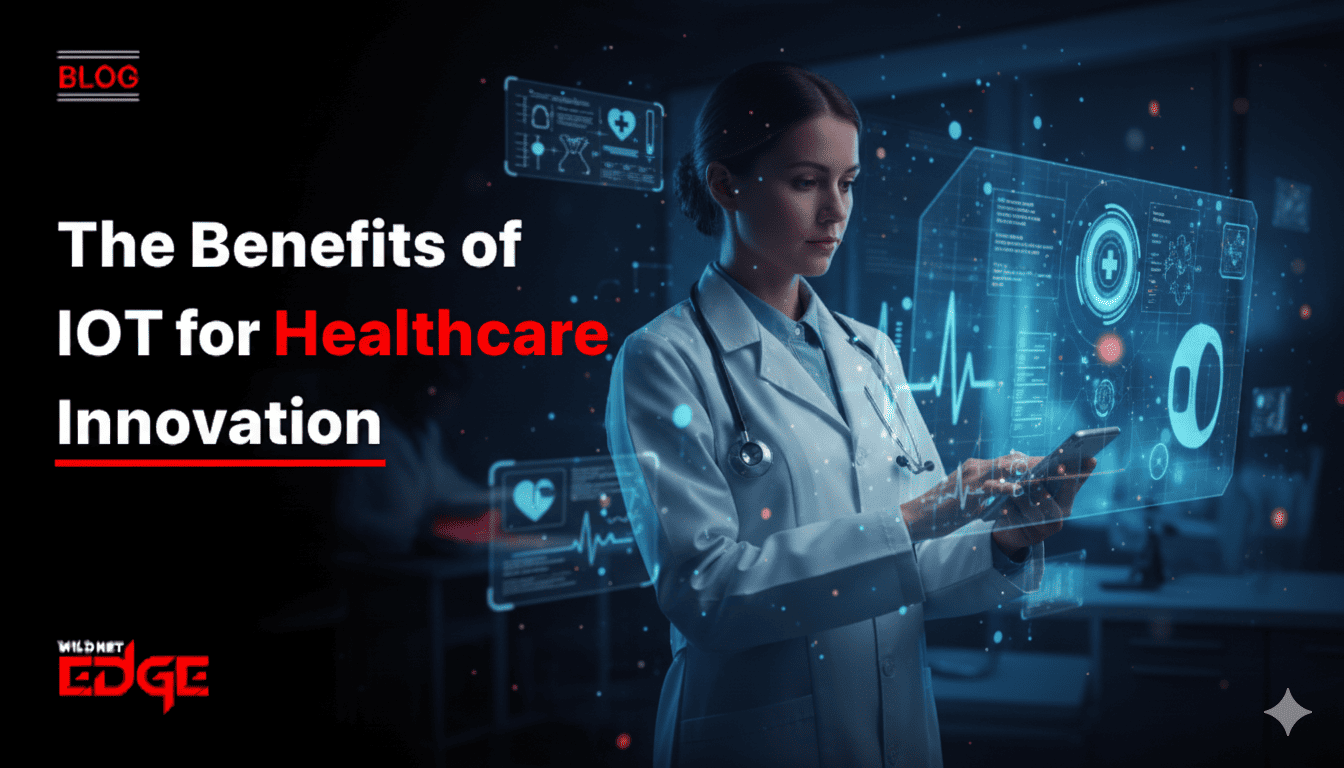TL;DR
This article explores the significant impact of the Internet of Things in the healthcare industry, explaining how it enables a fundamental shift from reactive to proactive patient care. It details how connected medical devices facilitate real-time remote patient monitoring, leading to better management of chronic diseases and reduced hospital readmissions. The guide also covers how IoT healthcare solutions improve hospital operational efficiency through smart asset tracking and optimized workflows. It further emphasises that adopting an IoT strategy is crucial for enhancing patient outcomes, reducing costs, and delivering a more personalised standard of care in a rapidly evolving digital landscape.
The healthcare landscape is undergoing its most significant transformation. The traditional, facility-centric model of care is paving the way to a more connected, continuous, and patient-centric approach. At the heart of this revolution is the Internet of Things (IoT). The strategic implementation of IoT in healthcare is not just about adopting new gadgets; it’s about building an intelligent, data-driven ecosystem that leads to better patient outcomes and more efficient operations.
What is IoT in Healthcare?
IoT in healthcare, often called the Internet of Medical Things, is a network of interconnected medical devices, sensors, software applications, and health systems. These connected medical devices ranging from wearable fitness trackers and smart glucose monitors to in-hospital equipment, collect and transmit real-time health data over the Internet.
This constant stream of data is then analyzed to provide a continuous, holistic view of a patient’s health. It breaks down the walls of the hospital, allowing for care to be delivered wherever the patient is. This is a paradigm shift that turns episodic health check-ups into a continuous care journey. To build these complex systems, organizations often partner with a specialized IoT Development Company.
The Core Benefits of IoT Healthcare Solutions
The applications of IoT in healthcare are vast, but they all drive toward a few core business and clinical benefits.
Enhanced Remote Patient Monitoring (RPM)
This is the most powerful application of IoT in healthcare. For patients with chronic conditions like diabetes, hypertension, or heart disease, connected medical devices can monitor their vital signs from the comfort of their own homes. This data is transmitted to their care team in real time, who can intervene at the first sign of a problem. This improves the patient’s quality of life and dramatically reduces costly hospital readmissions.
Improved Operational Efficiency in Hospitals
Hospitals are complex environments with thousands of moving parts. IoT can bring a new level of intelligence to hospital operations.
- Asset Tracking: Smart tags can be placed on critical equipment like wheelchairs and infusion pumps, allowing staff to locate them instantly. This reduces the time staff spend searching for equipment and improves asset utilisation.
- Workflow Optimisation: IoT sensors can monitor patient flow, wait times, and room occupancy, providing administrators with the data needed to optimise workflows and reduce bottlenecks.
More Personalized and Proactive Patient Care
The data gathered from connected medical devices allows for a much deeper and more personal understanding of a patient’s health. Instead of making decisions based on a single data point from a check-up, clinicians can analyze trends over time. This allows for the creation of highly personalized treatment plans and a shift towards preventative care, addressing potential health issues before they become critical.
IoT-Enabled vs. Traditional Healthcare: A Clear Difference
The shift from a traditional model to an IoT-enabled one is a fundamental change in the philosophy of care.
| Feature | Traditional Healthcare | IoT-Enabled Healthcare |
| Data Collection | Episodic, during in-person visits. | Continuous, real-time data from anywhere. |
| Care Model | Reactive (treating sickness). | Proactive and preventative (maintaining wellness). |
| Patient Engagement | Low, limited to appointments. | High, with patients actively participating in their care. |
| Efficiency | Manual processes, prone to delays. | Automated workflows, data-driven optimization. |
| Insight | Limited to a snapshot in time. | Holistic view of long-term health trends. |
Our IoT in Healthcare Services in Action: Case Studies
Case Study 1: A Chronic Disease Management Platform
- The Challenge: A large healthcare provider wanted to launch a remote monitoring program for its diabetic patients to reduce hospitalizations and improve their quality of life.
- Our Solution: As their chosen Custom App Development Company, we built a complete IoT platform. This included a patient-facing mobile app that synced with smart glucose meters and a clinician-facing dashboard that provided real-time alerts and trend analysis.
- The Result: The program reduced emergency room visits for diabetic complications by 40% among enrolled patients. Patient satisfaction scores also increased significantly due to the convenience and sense of security the platform provided.
Case Study 2: A Smart Hospital Asset Tracking System
- The Challenge: A major hospital was losing hundreds of thousands of dollars annually in lost or underutilized medical equipment. Nurses were spending up to an hour per shift searching for necessary devices.
- Our Solution: We implemented an IoT in healthcare solution using Bluetooth Low Energy tags and a network of sensors. We developed a custom application that provided a real-time hospital map, showing the exact location of every tagged piece of equipment.
- The Result: The hospital reduced equipment loss by 90% and improved asset utilization by 30%. The time nurses spent searching for equipment was virtually eliminated, allowing them to spend more time on direct patient care.
Our Technology Stack for IoT Healthcare Solutions
We use a secure, scalable, and HIPAA-compliant stack to build our IoT healthcare solutions.
- IoT Platforms: AWS IoT, Microsoft Azure IoT Hub
- Connectivity: Bluetooth (BLE), Wi-Fi, Cellular (LTE-M/NB-IoT)
- Data Processing: Kafka, Spark, InfluxDB
- Backend: Node.js, Python
- Mobile & Web: React Native, Swift, Kotlin, Angular
Conclusion
The adoption of IoT in healthcare is not just an incremental improvement; it is a fundamental shift that is creating a more connected and intelligent health ecosystem. From enabling proactive care with connected medical devices to streamlining hospital operations, these IoT healthcare solutions are delivering immense value. For healthcare organizations, a strategic investment in this technology is the key to a more sustainable and patient-centric future.
Ready to build the future of healthcare? Wildnet Edge is your expert partner in creating innovative and compliant Software Development Solutions. Our AI-first approach ensures we build systems that not only collect data but also turn it into actionable, life-saving insights.
FAQs
Security is the absolute top priority. It requires a multi-layered approach, including end-to-end data encryption, secure device provisioning, and a HIPAA-compliant cloud infrastructure. A robust governance framework is non-negotiable for any project involving IoT in healthcare.
One biggest barrier is integration with legacy systems, such as Electronic Health Records. A successful implementation requires a clear integration strategy to ensure that data from new connected medical devices can flow seamlessly into the existing clinical workflow.
The most significant strategic advantage is the shift to a value-based care model. By using data to keep patients healthier and out of the hospital, providers can move away from the traditional fee-for-service model and align their financial success with positive patient outcomes.
It augments their roles. IoT frees up clinicians from routine tasks by automating data collection and providing real-time alerts. This allows them to focus on what they do best: making complex clinical decisions and providing empathetic, human-centred care. A Product Development Company can help design tools that fit seamlessly into these workflows.
A well-defined pilot project, such as a remote monitoring program for a small cohort of patients, can often be launched within 4 to 6 months. This allows you to prove the value and refine the process before a large-scale rollout.
Yes, in many cases. Older medical equipment can often be “smartened” by retrofitting it with external sensors that connect to your IoT network. This is a cost-effective way to modernize your assets without having to replace everything.
The best way is to start with a specific, high-impact problem. Instead of a vague goal to “do IoT,” focus on a clear challenge, such as reducing readmission rates for a specific condition. This focused approach, often guided by experts in Custom Software Development Services, ensures your first project delivers measurable results.

Nitin Agarwal is a veteran in custom software development. He is fascinated by how software can turn ideas into real-world solutions. With extensive experience designing scalable and efficient systems, he focuses on creating software that delivers tangible results. Nitin enjoys exploring emerging technologies, taking on challenging projects, and mentoring teams to bring ideas to life. He believes that good software is not just about code; it’s about understanding problems and creating value for users. For him, great software combines thoughtful design, clever engineering, and a clear understanding of the problems it’s meant to solve.
 sales@wildnetedge.com
sales@wildnetedge.com +1 (212) 901 8616
+1 (212) 901 8616 +1 (437) 225-7733
+1 (437) 225-7733































